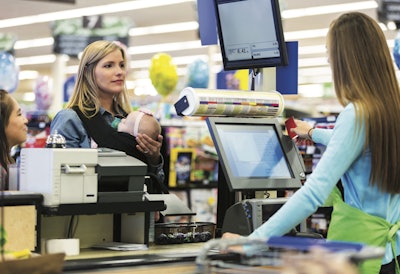
First, it helps to offer some perspective on where grocery sales fall on the e-commerce growth spectrum.
Business-to-business e-commerce sales make up the vast majority of e-commerce transactions. Forrester estimates that B-2-B e-commerce sales in the US will top $1 trillion by 2020.
This is a complex market where an OEM sets up an account with a motor supplier, for instance, and orders on-line through a special page with pricing, payment terms, discounts, etc., all established beforehand. To add to the complexity, industrial products can also be ordered through a variety of on-line marketplaces and networks. Think repeat business! Grainger, for example, now does approximately 58% of its sales by e-commerce, according to Digital Commerce 360.
To get some perspective, the B-2-C e-commerce market in the US was only $304.9 billion in 2014, according to the US Department of Commerce. This is where the consumer orders on-line from a website for home delivery, and includes shoes, clothes, home goods, jewelry, electronics, books, etc. Home goods, in particular, are a “hot growth” area right now. Most experts agree this B-2-C market is less than half the size of B-2-B.
Where do grocery sales fit in? Online grocery sales are predicted to capture 20% of total grocery retail by 2025 to reach $100 billion in consumer sales, according to a study by the Food Marketing Institute conducted by Nielsen. Estimates of online grocery’s share of the total $641 billion U.S. grocery market range between 2% to 4.3% according to FMI-Nielsen. This particular report predicts that grocery is the next major retail sector to be disrupted by e-commerce.
So grocery sales by e-commerce are a very small segment of total e-commerce sales, but the numbers are expected to keep growing. CPGs are worried, and experts predict we will all be buying some but not all groceries this way in the future. And as powerful as Amazon is, at a recent dairy forum, one analyst predicted Alibaba could overtake Amazon by 2025. Barrons recently ran a piece speculating what would happen if Alibaba and Kroger teamed up.
Also, some analysts point out that the U.S. is one of the smallest markets compared to Asia Pacific, Mid-East and Africa or even Latin America where adoption has been faster.
E-commerce grocery orders for home delivery reportedly appeal mostly to affluent or younger shoppers. Will the appeal spread to the masses, some analysts ask? One researcher found nearly 60% of household shoppers reported liking the in-store experience of shopping with family members. (More on in-store vs. e-commerce shopping later.)
Looking more closely at e-commerce, grocery orders can be handled in a variety of ways. Many shoppers are starting to “click and collect” where they order by computer, but drive themselves to the store for pick up. Others are ordering from local stores and the local supermarket delivers. Presumably there would be no special package here, the products would come from the local store shelf.
Then you have the Amazon and Walmart models where packages could very well be designed especially for home delivery in custom formats and with promotional offerings, perhaps with built-in connectivity to engage consumers. Here is where the most disruption will occur, but many are still not sure exactly what it means.
Last fall in Las Vegas, PMMI Business Intelligence conducted interviews with fifty CPGs and OEMs about a variety of topics including e-commerce. The general consensus in the report, “Top To Top Summit Report 2017,” was that most CPGs know they have to do something and many have budgets to explore options, but they’re not crystal clear on strategy yet. Some CPGs mentioned Amazon wagging the dog, much like Walmart championed sustainability. They feel pressure to follow and participate, and some fear the social media backlash if they do not have e-commerce options.
Grocery sales are lagging behind, in particular, as consumers struggle to overcome reluctance to order meat, poultry, seafood, fruit and vegetables without hands-on inspection. Retailers are starting off these new consumers with sales of other packaged products to ease them into the idea of ordering on-line.
In fact, Amazon’s most popular grocery category is beverages, followed by coffee, snack foods, breakfast foods and candy, according to Forbes. “Starting with these non-perishables, consumers get the feel for online ordering and delivery and gain confidence to include dairy, meat, frozen foods and fruits and vegetables in their next order,” says a recent Forbes article on Amazon’s climb to the top.
Amazon, of course, currently leads the pack with twice as much market share as closest competitor Walmart. According to One-Click Retail, also cited in the Forbes piece, “In 2017, Amazon attained a market share of 18% of online grocery sales in the US, double the share held by its closest competitor Walmart…with the estimated $2 billion in food and beverage sales.” But the situation is very fluid.
Additional research by Forrester and others indicates that currently most e-commerce carts are full of non-food items like paper goods, or bulk packages such as pet food and litter too heavy for the shopper to carry. As opposed to in-store carts where the majority of products are food and beverage.
In fact, e-commerce is perfect for “stock ups,” household goods regularly consumed such as shampoo and conditioner, cosmetics, detergents and soaps, napkins, paper towels, toilet paper, and dental hygiene products. Food and beverage is another story, and for the reasons cited above it is coming along more slowly by all reports. Fresh and frozen selections are even more problematic because they offer special challenges in temperature control.
A big issue is, how heavy or bulky is this product and how efficient is it to ship it? Take note: Most consumers demand free shipping! Who pays for the cold packs to stabilize temperature if need be? And what happens to packaging, loose fill, etc., after the delivery is unpackaged?
And how does a package created specifically for e-commerce then deliver on the brand experience when unpacked and “living” in the home? And where does sustainability play a role here? Home meal ingredient delivery services have already drawn public outcry on the amounts of packaging coming in the box.
Packaging designers at CPGs are exploring how to accommodate e-commerce shoppers, without diluting established brand iconic shapes, labels, etc. The picture is still murky.
But all agree there is an opportunity to engage a particular segment of shoppers that promises big returns and prompts discussions about special e-commerce product launches, new packages and promotions and getting closer to the consumer.
Packaging machinery OEMs are highlighting end-of-line equipment offerings for the fulfillment warehouses dotting the landscape.
“Not only does e-commerce offer opportunities for our members to manufacture end of line packaging equipment like case erectors, sealing, labeling, marking and coding equipmentforfulfillment facilities, our members’ customers (CPGs) are rethinking their brands to address e-commerce opportunities,” says Jim Pittas, COO of PMMI, The Association for Packaging and Processing Technologies.
Some early adopters are pioneering e-commerce offerings, and Packaging World’s Ann Marie Mohan has written extensively on these efforts, here is a collection of her most recent articles.
PMMI Business Intelligence will release a new report on how e-commerce is disrupting the packaging industry later this Fall in conjunction with PACK EXPO International, October 14-17 in Chicago.
Sources: Forbes, Nielsen, Food Marketing Institute, Digital Commerce 360, Forrester, One-Click Retail, PMMI Business Intelligence, U.S. Department of Commerce, Barrons, and ProFood World. Top to Top Summit 2017 Report. Download here.
First, it helps to offer some perspective on where grocery sales fall on the e-commerce growth spectrum.
Business-to-business e-commerce sales make up the vast majority of e-commerce transactions. Forrester estimates that B-2-B e-commerce sales in the US will top $1 trillion by 2020.
This is a complex market where an OEM sets up an account with a motor supplier, for instance, and orders on-line through a special page with pricing, payment terms, discounts, etc., all established beforehand. To add to the complexity, industrial products can also be ordered through a variety of on-line marketplaces and networks. Think repeat business! Grainger, for example, now does approximately 58% of its sales by e-commerce, according to Digital Commerce 360.
To get some perspective, the B-2-C e-commerce market in the US was only $304.9 billion in 2014, according to the US Department of Commerce. This is where the consumer orders on-line from a website for home delivery, and includes shoes, clothes, home goods, jewelry, electronics, books, etc. Home goods, in particular, are a “hot growth” area right now. Most experts agree this B-2-C market is less than half the size of B-2-B.
Where do grocery sales fit in? Online grocery sales are predicted to capture 20% of total grocery retail by 2025 to reach $100 billion in consumer sales, according to a study by the Food Marketing Institute conducted by Nielsen. Estimates of online grocery’s share of the total $641 billion U.S. grocery market range between 2% to 4.3% according to FMI-Nielsen. This particular report predicts that grocery is the next major retail sector to be disrupted by e-commerce.
So grocery sales by e-commerce are a very small segment of total e-commerce sales, but the numbers are expected to keep growing. CPGs are worried, and experts predict we will all be buying some but not all groceries this way in the future. And as powerful as Amazon is, at a recent dairy forum, one analyst predicted Alibaba could overtake Amazon by 2025. Barrons recently ran a piece speculating what would happen if Alibaba and Kroger teamed up.
Also, some analysts point out that the U.S. is one of the smallest markets compared to Asia Pacific, Mid-East and Africa or even Latin America where adoption has been faster.
E-commerce grocery orders for home delivery reportedly appeal mostly to affluent or younger shoppers. Will the appeal spread to the masses, some analysts ask? One researcher found nearly 60% of household shoppers reported liking the in-store experience of shopping with family members. (More on in-store vs. e-commerce shopping later.)
Looking more closely at e-commerce, grocery orders can be handled in a variety of ways. Many shoppers are starting to “click and collect” where they order by computer, but drive themselves to the store for pick up. Others are ordering from local stores and the local supermarket delivers. Presumably there would be no special package here, the products would come from the local store shelf.
Then you have the Amazon and Walmart models where packages could very well be designed especially for home delivery in custom formats and with promotional offerings, perhaps with built-in connectivity to engage consumers. Here is where the most disruption will occur, but many are still not sure exactly what it means.
Last fall in Las Vegas, PMMI Business Intelligence conducted interviews with fifty CPGs and OEMs about a variety of topics including e-commerce. The general consensus in the report, “Top To Top Summit Report 2017,” was that most CPGs know they have to do something and many have budgets to explore options, but they’re not crystal clear on strategy yet. Some CPGs mentioned Amazon wagging the dog, much like Walmart championed sustainability. They feel pressure to follow and participate, and some fear the social media backlash if they do not have e-commerce options.
Grocery sales are lagging behind, in particular, as consumers struggle to overcome reluctance to order meat, poultry, seafood, fruit and vegetables without hands-on inspection. Retailers are starting off these new consumers with sales of other packaged products to ease them into the idea of ordering on-line.
In fact, Amazon’s most popular grocery category is beverages, followed by coffee, snack foods, breakfast foods and candy, according to Forbes. “Starting with these non-perishables, consumers get the feel for online ordering and delivery and gain confidence to include dairy, meat, frozen foods and fruits and vegetables in their next order,” says a recent Forbes article on Amazon’s climb to the top.
Amazon, of course, currently leads the pack with twice as much market share as closest competitor Walmart. According to One-Click Retail, also cited in the Forbes piece, “In 2017, Amazon attained a market share of 18% of online grocery sales in the US, double the share held by its closest competitor Walmart…with the estimated $2 billion in food and beverage sales.” But the situation is very fluid.
Additional research by Forrester and others indicates that currently most e-commerce carts are full of non-food items like paper goods, or bulk packages such as pet food and litter too heavy for the shopper to carry. As opposed to in-store carts where the majority of products are food and beverage.
In fact, e-commerce is perfect for “stock ups,” household goods regularly consumed such as shampoo and conditioner, cosmetics, detergents and soaps, napkins, paper towels, toilet paper, and dental hygiene products. Food and beverage is another story, and for the reasons cited above it is coming along more slowly by all reports. Fresh and frozen selections are even more problematic because they offer special challenges in temperature control.
A big issue is, how heavy or bulky is this product and how efficient is it to ship it? Take note: Most consumers demand free shipping! Who pays for the cold packs to stabilize temperature if need be? And what happens to packaging, loose fill, etc., after the delivery is unpackaged?
And how does a package created specifically for e-commerce then deliver on the brand experience when unpacked and “living” in the home? And where does sustainability play a role here? Home meal ingredient delivery services have already drawn public outcry on the amounts of packaging coming in the box.
Packaging designers at CPGs are exploring how to accommodate e-commerce shoppers, without diluting established brand iconic shapes, labels, etc. The picture is still murky.
But all agree there is an opportunity to engage a particular segment of shoppers that promises big returns and prompts discussions about special e-commerce product launches, new packages and promotions and getting closer to the consumer.
Packaging machinery OEMs are highlighting end-of-line equipment offerings for the fulfillment warehouses dotting the landscape.
“Not only does e-commerce offer opportunities for our members to manufacture end of line packaging equipment like case erectors, sealing, labeling, marking and coding equipmentforfulfillment facilities, our members’ customers (CPGs) are rethinking their brands to address e-commerce opportunities,” says Jim Pittas, COO of PMMI, The Association for Packaging and Processing Technologies.
Some early adopters are pioneering e-commerce offerings, and Packaging World’s Ann Marie Mohan has written extensively on these efforts, here is a collection of her most recent articles.
PMMI Business Intelligence will release a new report on how e-commerce is disrupting the packaging industry later this Fall in conjunction with PACK EXPO International, October 14-17 in Chicago.
Sources: Forbes, Nielsen, Food Marketing Institute, Digital Commerce 360, Forrester, One-Click Retail, PMMI Business Intelligence, U.S. Department of Commerce, Barrons, and ProFood World. Top to Top Summit 2017 Report. Download here.
First, it helps to offer some perspective on where grocery sales fall on the e-commerce growth spectrum.
Business-to-business e-commerce sales make up the vast majority of e-commerce transactions. Forrester estimates that B-2-B e-commerce sales in the US will top $1 trillion by 2020.
This is a complex market where an OEM sets up an account with a motor supplier, for instance, and orders on-line through a special page with pricing, payment terms, discounts, etc., all established beforehand. To add to the complexity, industrial products can also be ordered through a variety of on-line marketplaces and networks. Think repeat business! Grainger, for example, now does approximately 58% of its sales by e-commerce, according to Digital Commerce 360.
To get some perspective, the B-2-C e-commerce market in the US was only $304.9 billion in 2014, according to the US Department of Commerce. This is where the consumer orders on-line from a website for home delivery, and includes shoes, clothes, home goods, jewelry, electronics, books, etc. Home goods, in particular, are a “hot growth” area right now. Most experts agree this B-2-C market is less than half the size of B-2-B.
Where do grocery sales fit in? Online grocery sales are predicted to capture 20% of total grocery retail by 2025 to reach $100 billion in consumer sales, according to a study by the Food Marketing Institute conducted by Nielsen. Estimates of online grocery’s share of the total $641 billion U.S. grocery market range between 2% to 4.3% according to FMI-Nielsen. This particular report predicts that grocery is the next major retail sector to be disrupted by e-commerce.
So grocery sales by e-commerce are a very small segment of total e-commerce sales, but the numbers are expected to keep growing. CPGs are worried, and experts predict we will all be buying some but not all groceries this way in the future. And as powerful as Amazon is, at a recent dairy forum, one analyst predicted Alibaba could overtake Amazon by 2025. Barrons recently ran a piece speculating what would happen if Alibaba and Kroger teamed up.
Also, some analysts point out that the U.S. is one of the smallest markets compared to Asia Pacific, Mid-East and Africa or even Latin America where adoption has been faster.
E-commerce grocery orders for home delivery reportedly appeal mostly to affluent or younger shoppers. Will the appeal spread to the masses, some analysts ask? One researcher found nearly 60% of household shoppers reported liking the in-store experience of shopping with family members. (More on in-store vs. e-commerce shopping later.)
Looking more closely at e-commerce, grocery orders can be handled in a variety of ways. Many shoppers are starting to “click and collect” where they order by computer, but drive themselves to the store for pick up. Others are ordering from local stores and the local supermarket delivers. Presumably there would be no special package here, the products would come from the local store shelf.
Then you have the Amazon and Walmart models where packages could very well be designed especially for home delivery in custom formats and with promotional offerings, perhaps with built-in connectivity to engage consumers. Here is where the most disruption will occur, but many are still not sure exactly what it means.
Last fall in Las Vegas, PMMI Business Intelligence conducted interviews with fifty CPGs and OEMs about a variety of topics including e-commerce. The general consensus in the report, “Top To Top Summit Report 2017,” was that most CPGs know they have to do something and many have budgets to explore options, but they’re not crystal clear on strategy yet. Some CPGs mentioned Amazon wagging the dog, much like Walmart championed sustainability. They feel pressure to follow and participate, and some fear the social media backlash if they do not have e-commerce options.
Grocery sales are lagging behind, in particular, as consumers struggle to overcome reluctance to order meat, poultry, seafood, fruit and vegetables without hands-on inspection. Retailers are starting off these new consumers with sales of other packaged products to ease them into the idea of ordering on-line.
In fact, Amazon’s most popular grocery category is beverages, followed by coffee, snack foods, breakfast foods and candy, according to Forbes. “Starting with these non-perishables, consumers get the feel for online ordering and delivery and gain confidence to include dairy, meat, frozen foods and fruits and vegetables in their next order,” says a recent Forbes article on Amazon’s climb to the top.
Amazon, of course, currently leads the pack with twice as much market share as closest competitor Walmart. According to One-Click Retail, also cited in the Forbes piece, “In 2017, Amazon attained a market share of 18% of online grocery sales in the US, double the share held by its closest competitor Walmart…with the estimated $2 billion in food and beverage sales.” But the situation is very fluid.
Additional research by Forrester and others indicates that currently most e-commerce carts are full of non-food items like paper goods, or bulk packages such as pet food and litter too heavy for the shopper to carry. As opposed to in-store carts where the majority of products are food and beverage.
In fact, e-commerce is perfect for “stock ups,” household goods regularly consumed such as shampoo and conditioner, cosmetics, detergents and soaps, napkins, paper towels, toilet paper, and dental hygiene products. Food and beverage is another story, and for the reasons cited above it is coming along more slowly by all reports. Fresh and frozen selections are even more problematic because they offer special challenges in temperature control.
A big issue is, how heavy or bulky is this product and how efficient is it to ship it? Take note: Most consumers demand free shipping! Who pays for the cold packs to stabilize temperature if need be? And what happens to packaging, loose fill, etc., after the delivery is unpackaged?
And how does a package created specifically for e-commerce then deliver on the brand experience when unpacked and “living” in the home? And where does sustainability play a role here? Home meal ingredient delivery services have already drawn public outcry on the amounts of packaging coming in the box.
Packaging designers at CPGs are exploring how to accommodate e-commerce shoppers, without diluting established brand iconic shapes, labels, etc. The picture is still murky.
But all agree there is an opportunity to engage a particular segment of shoppers that promises big returns and prompts discussions about special e-commerce product launches, new packages and promotions and getting closer to the consumer.
Packaging machinery OEMs are highlighting end-of-line equipment offerings for the fulfillment warehouses dotting the landscape.
“Not only does e-commerce offer opportunities for our members to manufacture end of line packaging equipment like case erectors, sealing, labeling, marking and coding equipmentforfulfillment facilities, our members’ customers (CPGs) are rethinking their brands to address e-commerce opportunities,” says Jim Pittas, COO of PMMI, The Association for Packaging and Processing Technologies.
Some early adopters are pioneering e-commerce offerings, and Packaging World’s Ann Marie Mohan has written extensively on these efforts, here is a collection of her most recent articles.
PMMI Business Intelligence will release a new report on how e-commerce is disrupting the packaging industry later this Fall in conjunction with PACK EXPO International, October 14-17 in Chicago.
Sources: Forbes, Nielsen, Food Marketing Institute, Digital Commerce 360, Forrester, One-Click Retail, PMMI Business Intelligence, U.S. Department of Commerce, Barrons, and ProFood World. Top to Top Summit 2017 Report. Download here.
First, it helps to offer some perspective on where grocery sales fall on the e-commerce growth spectrum.
Business-to-business e-commerce sales make up the vast majority of e-commerce transactions. Forrester estimates that B-2-B e-commerce sales in the US will top $1 trillion by 2020.
This is a complex market where an OEM sets up an account with a motor supplier, for instance, and orders on-line through a special page with pricing, payment terms, discounts, etc., all established beforehand. To add to the complexity, industrial products can also be ordered through a variety of on-line marketplaces and networks. Think repeat business! Grainger, for example, now does approximately 58% of its sales by e-commerce, according to Digital Commerce 360.
To get some perspective, the B-2-C e-commerce market in the US was only $304.9 billion in 2014, according to the US Department of Commerce. This is where the consumer orders on-line from a website for home delivery, and includes shoes, clothes, home goods, jewelry, electronics, books, etc. Home goods, in particular, are a “hot growth” area right now. Most experts agree this B-2-C market is less than half the size of B-2-B.





















